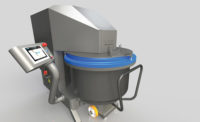When it comes to using robotic equipment, U.S. bakers and snack producers still lag behind manufacturers in other industries, as well as their counterparts in other countries. Cost, return on investment (ROI) and a reluctance to deviate from traditional manufacturing practices are just a few reasons why many American bakers and snack producers seems to be hesitant about investing in robotic equipment.
“With some exceptions, [the adoption rate of robotic equipment in the bakery and snack industry] is well behind that of most other industries,” echoes Rick Hoskins, director of sales and marketing, Colborne Foodbotics, L.L.C., Lake Forest, Ill. Colborne offers automated systems for food processing and packaging. “The baking industry started installing some robotic systems during the 1990s and had some bad experiences caused by early-generation robots and controls. Colborne started promoting robotic systems in 2001 and has had to work hard to convince baking and snack customers to accept this new, improved technology,” he says.
Earl Wohlrab, palletizing and robotics systems product manager for Intelligrated, a Cincinnati-based, single-point provider of automated materials-handling solutions, concurs: “Bakery is a pretty traditional market space. [Many bakeries] are fairly mature, so they have been doing things a certain way for a long time.”
Derek Rickard, distribution systems manager for RMT Robotics, Grimsby, Ontario, notes that “the adoption rate of robotic equipment in Europe has, so far, been much higher than in North America, mostly due to tighter space constraints and higher labor rates.” A Cimcorp Oy company, RMT Robotics is a manufacturer and integrator of turnkey, robotic, gantry-based order fulfillment and tire-handling solutions.
Rickard adds, however, that “fast [stock-keeping unit] (SKU) growth and the smaller line-item orders that follow are encouraging North American snack food and bakery companies to look to automation, not only to alleviate current constraints, but also to provide a framework for future growth and flexibility.”
Wohlrab also thinks some bakeries and snack producers are starting to modernize like other businesses. “They’re starting to realize that robotics is a better fit for them, especially for short runs or lower line speeds,” he says. “They can do consolidation on the palletizing or packaging end.”
According to Craig Collett, director of the robotics and wrapping product line at Bosch Packaging Technology Inc., New Richmond, Wis., large bakeries have been using robotics successfully for many years. His company is now seeing robotic adoption spread to midsize and small bakeries as the technology becomes more accessible.
Palletizing
Bakeries and snack producers venturing into robotics are primarily doing so in several areas: Palletizing; primary and secondary packaging; and warehouse automation.
According to Matthew Garcia, robotics product line manager for Thiele Technologies Inc., a Minneapolis-based designer, manufacturer and integrator of high-speed packaging equipment solutions, baking companies often start automating “the low-hanging fruit”—palletizing or secondary packaging—first.
“Bakeries involved in robotics are taking that route first because they can reap the benefits much quicker,” he says.
Thiele Technologies’ new Econo-Pal robotic palletizer, for instance, is an entry-level palletizing system with a small footprint that can help small companies in a variety of industries, including bakeries, ease into robotics. “By entry-level, I mean fewer features, lower cost, easy setup and less installation and programming time,” Garcia explains. “In a nutshell, it’s a simple system based on the idea that customers tell us what products they’re running. If they fit into the realm of the Econo-Pal, we build it and ship it to them as an out-of-the-box concept. They just open the box and put [the unit] in their plant. It’s easy and intuitive enough that they can just step through the manual and do the setup, teaching and production on their own. Of course, we’re always available if they need us.”
The Econo-Pal comes with the robot, an end-of-arm tool, an infeed, pallet locators, a fence, a base plate, a quick-change tool, drop-box detection, Category 3 safety compliance and an easy-to-use manual. Optional features are a pallet conveyor, a pallet and/or slipsheet dispenser, a mat-top conveyor, a programmable logic controller (PLC), a touchscreen, Ethernet connection, additional pallet patterns and other robotic models for heavier payloads and extended reach.
While the Econo-Pal’s case rate per minute is about 20—too low for some industries or large manufacturers—the model offers smaller manufacturers numerous benefits. “The biggest benefit is being able to set it up very easily,” Garcia says. “Also, when you get into larger systems, the installation cost can be pretty high—into the tens of thousands of dollars because of all the electrical wiring that you have to run and the mechanical rigging. This system is not quite modular, but there are minimal pieces to install—fencing, an infeed conveyor, a robot and a pallet locator.”
Maintenance for the Econo-Pal is minimal, too. “Moving parts are always the killer when it comes to maintenance,” says Garcia. “On this particular system, the only moving parts are the robot and a rolling conveyor. The only things that have to be maintained, or perhaps repaired or replaced, are things like the vacuum cups and the infeed, where you may have to grease the gearboxes or bearings.” The vacuum cups and other parts can be purchased off the shelf or through Thiele, which can get them within 24 hours, keeping downtime to a minimum.
Garcia estimates a one to one-and-a-half year ROI for the Econo-Pal, which replaces just one operator. “It’s tough for manufacturers to justify the cost of a system that’s only going to be relieving one person’s duty,” he says. “However, it’s easier to justify [this one] because it’s such a low-cost system.”
“We’re sort of a solution provider—an integrator,” explains Intelligrated’s Wohlrab. “We do some equipment design work at the component level, but at the robotic level, it’s mostly integration.” The company’s Alvey Robotics line, for instance provides complete, integrated, robotic material-handling systems, including system design, fabrication, installation, commissioning and after-sales customer support.
Wohlrab explains that some of Intelligrated’s customers are using robotics to create intricate mixed product solutions—multiple product flavors in the same secondary packaging or multiple flavors of a product on one pallet—in-house, rather than sending homogenous product loads to second- and third-party solution providers to create mixed formats. “We’re now seeing some of our customers trying to move that piece of business back inside their own four walls,” he says, adding that bringing this work back in-house saves companies money and enables them to be more agile when it comes to meeting customer requests.
Primary and secondary packaging
Another area in which bakeries and snack producers are turning to robotics to improve efficiencies and reduce costs is primary and secondary packaging.
“Food manufacturers are using robots for both feed placing (primary packaging) and top loading (secondary packaging),” says Collett. “Case and carton loading is automated with robotics more often than primary packaging, but as end-effector technology continues to advance, feed placing applications are growing.”
Bosch, a supplier of delta robotics, conveying technologies and integrated packaging lines, recently made improvements to several areas of its robotic equipment, including its end-effector (picking and placing) technology. “Improvements in modeling the airflow of our vacuum end effectors have lead to advances in their design that lets us securely pick a wider range of raw or packaged products at high speeds,” Collett explains. “The vacuum systems themselves are also more robust and can handle products with particulates—like many bakery products—that previously might have clogged vacuum systems or end effectors.” As a result, a wider range of product packaging can now be automated with picking technology, including that for raw or unwrapped product.
In addition, Bosch has designed the construction of its robot cell for IP65 washdown, as well as to meet many current hygiene standards and regulations for food processing. A standard stainless-steel construction and a reduction of horizontal surfaces help facilitate cleaning.
“There is an increase in demand for sanitary design across industries due to food safety and allergen concerns,” Collett says. “Machine designs that once were used only for dairy and meat applications are being applied to bakery and snack food operations, among others, to meet their demands for washdown and other hygienic standards. Robots often reduce human contact with food along the packaging line and, therefore, increase the hygiene of a food packager’s operation.”
Bosch has also improved its robotic controls. The company’s Gemini 3 software, for instance, has a more intuitive interface and a 3D simulation feature that enables operators to adjust and optimize pick-and-place patterns and other settings for each product, enabling new recipes and production flows to be quickly tested and optimized. Data collection and overall equipment effectiveness (OEE) reporting have also been improved. According to Collett, these embellishments now allow small operations without robotics experience to integrate robotics into their operations.
Delta robots generally require less maintenance than traditional packaging equipment. “The robot arms themselves are virtually maintenance-free,” says Collett. The end effectors have wear parts, such as suction cups, which can be easily replaced. In addition, they can be removed without tools from the robot arm and completely submersed for cleaning.
As for a return on investment, “we generally see an ROI of no more than 12 to 18 months with our robotic automation projects,” says Collett. “It can be shorter for high-volume, three-shift operations, but this is the general range for one- to two-shift operations. It’s important to note that robotic installations often also require additional conveyors or other operations to fully integrate into existing lines.”
Smart machines
Dale Andersen, president and CEO of Minneapolis-based Delkor Systems Inc., also says robotics are now being used for a wide variety of food packaging applications. “If the product is of consistent size and packaging, at medium to high speeds, [robotics] usually offers a good fit,” he explains, adding that for snack bars, robotic equipment is now “the standard way to automate a packaging line.”
Delkor’s new M3-CL robotic loadcell is designed to combine maximum versatility with high operational efficiency. Part of a new generation of “smart” machines, the unit has a packing speed of up to 400 products per minute, can analyze and discharge defective product and comes equipped with an Allen Bradley PanelView Plus 700 graphic terminal with state-of-the-art diagnostics. When equipped with Delkor’s optional machine monitoring system, the robotic loadcell can also track and record machine input, output, downtime and more.
Other features include a compact size (6x6-ft.), welded stainless-steel frame, hygienic design, rapid changeover (one to two minutes per carton or product changeovers), top-of-the line components (Fanuc robotic arm, Alpha-Wittenstein gear boxes, Allen Bradley Compact Logic L-45 with PanelView Plus 700), HMI swing arm and Ethernet IP. Optional product bypass and a machine monitoring system are also available.
“Component selection is an important criteria for maintaining a dependable robotic cell,” says Andersen. “With proper component selection, size and weight of the cell’s frame, and product infeed and collation design, a robotic cell can be very dependable.”
Colborne Foodbotics’ Basket Load System (BBL) series, meanwhile, automatically loads wrapped product (loaves of bread, buns and rolls) into standard bakery route baskets or trays. According to Hoskins, the series “maintains the best system for reducing warehousing, transportation and distribution costs and improving store-level shelf appearance and quality.”
The company’s servo-controlled Muffin Transfer System de-pans up to four pans of muffins at a time and can be reconfigured for bulk or clamshell packaging. It handles throughput levels (30+ pans per minute) at 99.9%+ transfer efficiency and comes with a built-in closing system and clamshell de-nesters. “This is the most stable design available, capable of handling warm product with negligible cripples,” says Hoskins.
Colborne Foodbotics’ latest development, the Vision Guided Robotics (VGR) system, delivers a highly efficient and flexible automation solution for the high-speed packaging and/or assembly of unpackaged or packaged food products. According to Hoskins, a single line can handle 800-plus pieces of Texas Toast per minute from a spiral freezer, with 20-second buffering to keep the line running continuously through bag changeovers. The system uses robots to create variable stacks and load flights to a wrapper infeed.
All of these Colborne Foodbotics systems offer one-and-a-half to three-year paybacks on the investment, says Hoskins.
As for maintenance, Hoskins says, “Robotic systems are generally much cleaner in design and require far less regular and repair maintenance than conventional processing of packaging equipment. The robots themselves will operate 10-plus years with negligible maintenance. Since robots have such great dexterity these days, you need less handling and adjustments to locate, pick and place the target product. This results in fewer mechanisms on the conveyor, less clutter, better access, less lubrication and fewer breakdowns. Very rarely does a well-designed robotic system cause significant downtime.”
Gantry technology for warehouses
Warehouse automation typically is still “a very manual, intensive operation with huge potential for labor and efficiency savings,” says RMT Robotics’ Rickard.
Over the past two years, the company has launched and implemented two innovative and flexible robotic gantry technologies for snack and bakery warehouses. For companies distributing their products in cases, RMT Robotics has implemented an automated robotic case-picking system that runs 24 hours a day, picks from several hundred SKUs and has a capacity of 4 million cases per month. It currently is being used by a U.S. snack manufacturer, says Rickard.
For companies distributing products in trays (typically bread), RMT Robotics now sells the patented Multipick system in North America in cooperation with its Finnish sister company Cimcorp Oy. The system receives trays of bread from manufacturing and automatically stores the entire product in a dense grid on the floor, then picks and ships customer orders. The Multipick system has been implemented in 35 locations worldwide.
According to Rickard, systems offer similar benefits, such as managing rapid SKU growth better than a manual system, superior cube utilization, error-free picking and complete inventory traceability at all times.
“Robotic equipment for warehouses has been designed for superior reliability, as most warehouses have little, if any, maintenance staff,” say Rickard in regard to maintenance. “Also, compared to conventional manufacturing equipment, the robotic technology employed to pick cases tends to be less intricate and have less moving parts. Thus, the typical maintenance interval is four times per year.”
In addition, Rickard says the typical ROI for RMT Robotics’ customers is two to four years, adding “but that does not factor in additional advantages often overlooked when calculating ROI, such as space savings and improved efficiencies by providing 100% order-picking accuracy and traceability.”
The next wave
“I think there still is some hesitation for bakeries to get involved in robotics,” says Thiele Technologies’ Garcia, when asked about the next wave of innovation in robotics for the bakery and snack industry. “The ones that have already invested in [robotics] downstream—which is all the palletizing and case packing—they’re a little more receptive to looking at robotics for their upstream products.”
By upstream, Garcia means using robots to handle product after it’s baked or load raw product into pans. “When you start getting into the raw product, you’re looking at an unknown variable,” he acknowledges, explaining that it can be difficult to handle and impacts the sanitary design of the robotic equipment, both of which can raise costs for customers.
Bosch’s Collett, meanwhile, believes the hygienic design of robots sold into the bakery and snack industry will continue to improve as demand in this area increases. He adds that delta robots also will become more robust and capable of covering a wider range of applications as end-effector technology continues to improve.
When it comes to packaging, Wohlrab says robotic equipment for the bakery and snack markets is already “fairly sophisticated. I think the only thing they can realize is maybe fine-tuning their vision and increasing speed. From our aspect in the warehouse, we’re looking to do the same. We’re looking to always be faster, to stay in step with more traditional equipment.”
RMT Robotics also believes that as manufacturing plants approach full automation, the next wave of innovation will happen in the warehouse. “The future will see streamlined distribution centers through a mix of automated storage and picking, dynamic route planning software and truck cubing software, all which will reduce costs and offer customers a higher level of service and responsiveness,” contends Rickard.
“It is hard to imagine a good reason for a well-run food company not to at least consider upgrading to robotics if there is an abundance of people anywhere in its facility,” Hoskins adds. “Most often, the robotic system will improve product quality and generate cost savings that go well beyond the savings used to justify the project in the first place.”












